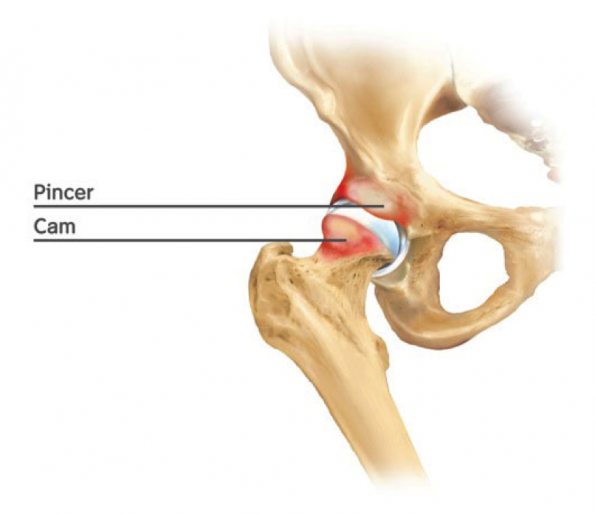YOUR PHYSIO
Condition directory
Femoroacetabular Impingement (Hip impingement)
Femoroacetabular Impingement (FAI) is a condition whereby the ball and socket of the hip joint (femoral head and acetabulum respectively) can meet awkwardly against each other, causing a bony ‘impingement’. All hips impinge at their extremes, but in hips with FAI this impingement can occur earlier and more readily in movement. The underlying cause of this is usually due to subtle differences in the shape / anatomy of the hip joint. Symptoms can be exacerbated by lifestyle, occupational and sporting activities. In some individuals, FAI can lead to symptoms of hip pain, stiffness and dysfunction. It can be a common cause of groin pain in a young adult. It is important to note that for the majority of individuals with FAI, there is no known underlying cause. FAI can lead to wear of the smooth surface covering of the hip joint, namely the articular cartilage. This in-turn can predispose an individual to developing osteoarthritis of the hip. It can also lead to a tear of the hip’s supporting cartilage known as the ‘labrum’. Labral tears, therefore, commonly co-exist with FAI.
There are two main types of hip impingement. Individuals may have either type or a combination of both. The two types of FAI are as follows:
Cam Impingement – this is caused by a subtle abnormality in the shape of the ‘head-neck junction’ just beneath the femoral head (the ball part of the ball and socket) impacting onto the edge of the cup or ‘acetabulum’ during certain hip movements.
Pincer Impingement – this occurs when there is direct contact between the acetabular edge and the ‘femoral neck’ or ‘head-neck junction’. This is usually because the socket is slightly deeper or backwards facing.

Treatment options include conservative and non-surgical management e.g. lifestyle and activity modification, physiotherapy, pain relieving medications, injection therapy and by addressing MSK risk factors. Surgical management options can be considered in some cases. Treatment very much depends on an individual’s presentation. The severity and underlying nature of the impingement, previous treatments, radiological features (i.e. x-ray and/or scan), a patient’s individual profile (including age, occupation, developmental or childhood conditions at the hip, injury history, sporting pursuits and aspirations) and any other health issues are taken into account.
Physiotherapy treatment aims to reduce pain and stiffness, optimize muscle strength and joint motion and review lifestyle factors which cause excessive contact between the impinging ball and socket.
Surgical treatment for FAI is usually in the form of a hip arthroscopy (or keyhole) surgery, performed by a specialist orthopaedic surgeon. Although similar in principle to arthroscopy of the knee, this surgery is quite involved and should not be deemed as a minor procedure. Rehabilitation following hip arthroscopy surgery is very important in determining the final clinical outcome and should be graded appropriately in conjunction with the surgeon’s post-operative instructions. It is generally accepted that if osteoarthritis has been established in the joint, arthroscopic treatment can be of limited value although research into this field continues.